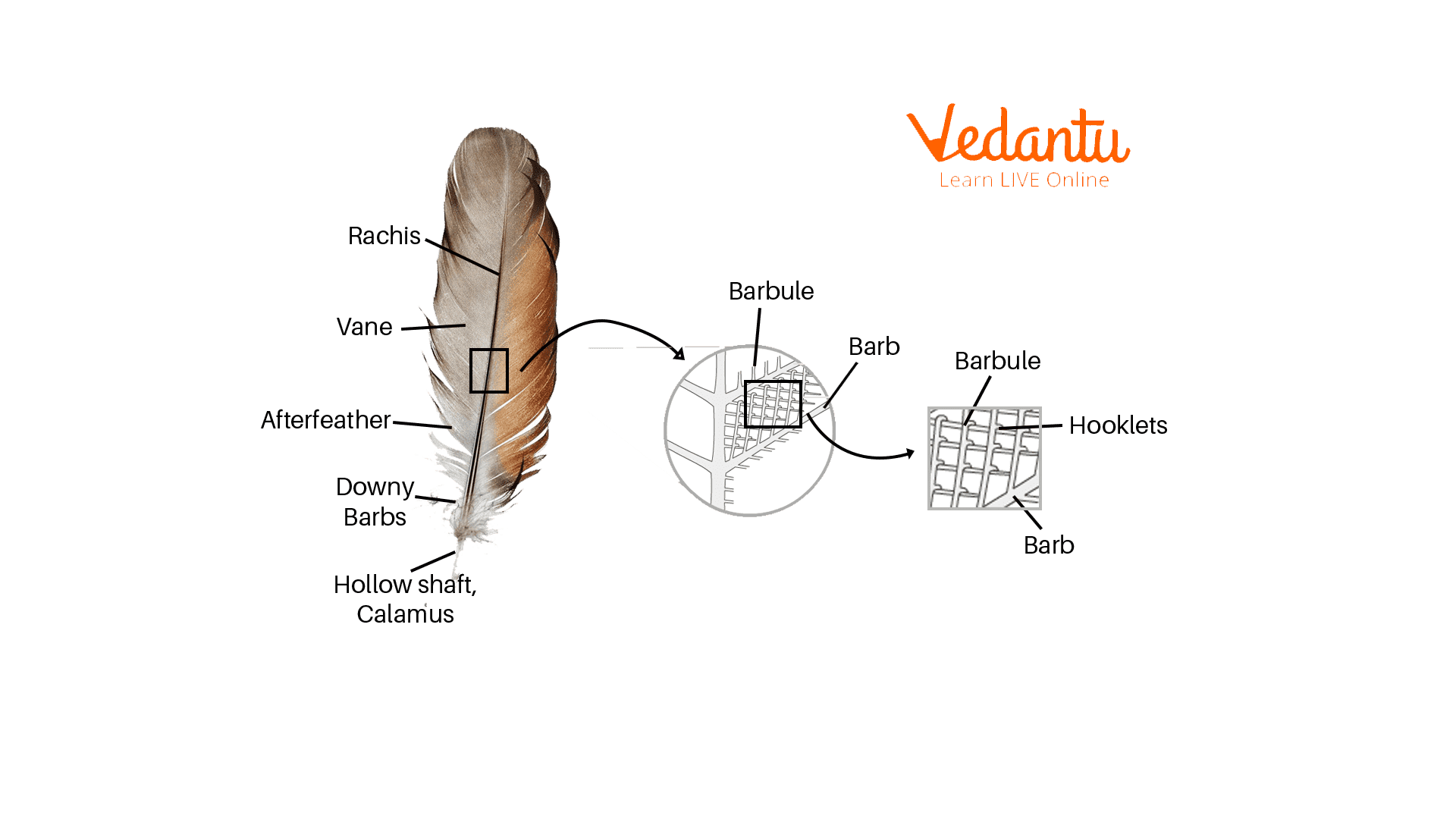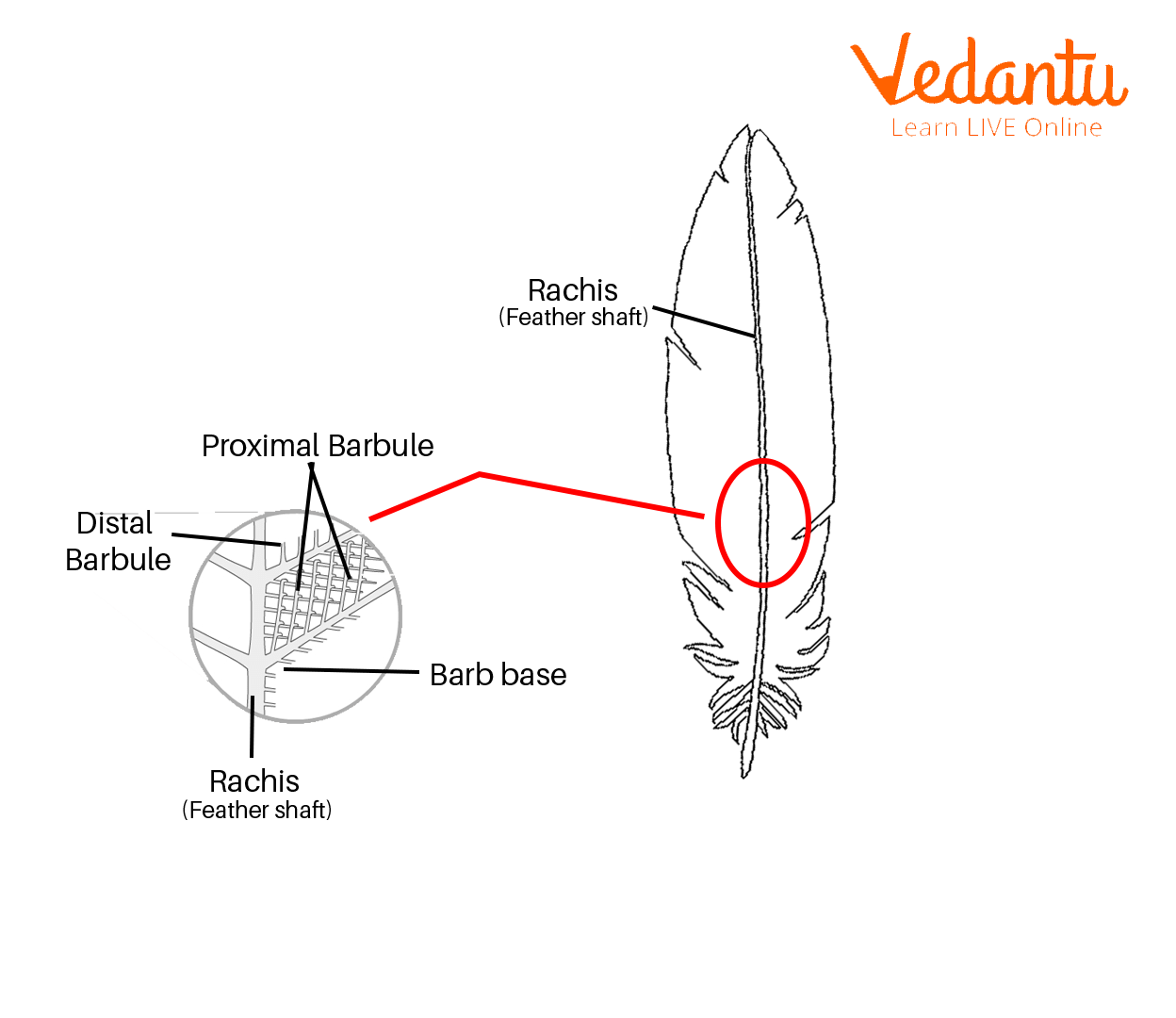Feathers: An Introduction
Feather is known as the component structure of all modern birds' flight surfaces and outer covering. Feathers apparently evolved from the scales of birds’ reptilian ancestors, being Unique to birds. Several different types of feathers are used for flight, insulation, body contour forming, sensory reception, and show reception.
What Are Feathers?
Feathers are the soft structures that cover the bodies of the birds. These are the epidermal growths found in birds. These are part of the integumentary system in avians and are the most complex system in vertebrates. Feathers are made of a special type of protein called beta keratin protein. Feathers are special structures used in flying.

Feather
Types of Feathers
There are usually six different types of feathers based on morphology.
Down Feathers - These feathers are very soft due to the absence of interlocking barbules of pennaceous feathers. This makes them very soft and fluffy. These feathers are found under the sturdier exterior feathers. Chicks of hens and young birds are covered by these types of feathers when they hatch. Mainly there are three types of down feathers - body down, powder down, and natal down feathers.
Contour Feathers - These are the exterior feathers of a bird that contribute shape and colour to the feathers. The upper part is waterproof and is made of barbs that form a stiff vane, the flat surface of the feather. The lower part of the feather helps in thermoregulation.
Semiplume Feathers - These feathers are the cross between the contour feather and the down feather. Interlocking in barbs is absent. These feathers mainly provide insulation to the birds.
Flight Feathers - These feathers are present on the tails and the wings. These are usually long feathers. As the name itself suggests, these birds help in flight.
Bristles Feathers - These feathers are a special type of feathers found around the eyelids, mouth, head, and neck. These feathers help the birds to know the speed and direction of the air. These also safeguard the bird's eyes from dust and insects.
Filoplume Feathers - These feathers look like paint brushes and are the smallest type of feathers. The exact function of these types of fears is still not known.

Down Feathers
Parts of a Feather
Let us discuss the parts of a feather in detail. The typical feather contains a central shaft (called rachis), with the serial paired branches (called barbs) forming a flattened, generally curved surface, called a vane. The barbules, as well as the barbs, have roots, and the barbules of neighbouring barbs are connected by hooks, stiffening the vane. In several birds, either some or all of the feathers lack the hooks or the barbules, and the plumage has a hairlike, loose appearance.
Usage of Feather
Feathers have been used as regalia and for ornamentation in several societies, both highly developed and nonliterate. Hats and other accouterments are featured or have been constructed totally of feathers and, at times, either entire wings or the pairs of wings down to modern times. Many governments have protected the colourful species of birds from preventing the extinction of feathers at the hands of feather hunters. Feathers from domestic fowl slaughtered for meat are given to poultry farmers as a regular by-product and are used for padding, decoration, and insulation.
Structures and Characteristics
Feathers are the most complex integumentary appendages found in vertebrates, and they are formed in tiny follicles that contain keratin proteins in the epidermis or outer skin layer.
The β-keratins in feathers, claws and beaks - and the claws, shells, and scales of reptiles - are composed of protein strands hydrogen-bonded into the β-pleated sheets, then, that are much stronger than -keratins of mammalian horns, hooves, and hair Disulfide bridges twist and crosslink the -keratins of mammalian horns, hooves, and hair into structures. The exact signals that cause the feather to grow on the skin are unclear, but transcription factor cDermo-1 has been discovered to cause the feather to grow on the skin and scales on the leg.
Function of Feathers
The important functions of feathers are given below:
Insulation - It is the most important function of feathers. Protect birds from water and cold.
Help in Flight - Feathers help in flying
Protection - Feathers protect birds from various poor or fluctuating conditions of the enviroment.
Visual Communication - They also help in communication.
Development of Feathers
The development of feathers started with the formation of the dermal papilla.
Then feather primordium formed from the growth of papilla and its inductor effect on the epidermis on the surface of the skin
Then feather follicles develop on or around the base of feather primordium
Feather sheath develop from epidermal cells
These epidermal columns develop into barbs
After the feather sheath split, fluffy barbs stretch out of the quarters and the shaft elongates.
Human Usage of Feathers
Utilitarian Functions
Feathers are both excellent and soft at trapping heat; therefore, sometimes they are used in high-class bedding, especially blankets, mattresses, and pillows. Also, they are used as filling for outdoor bedding and winter clothing, such as sleeping bags and quilted coats. Eiderdown and goose down have a lot of lofts, which means they can extend from a compressed state to catch a lot of insulating, compartmentalized air.
In Religion and Culture
Eagle feathers contain great spiritual and cultural value to the American Indians in the United States and First Nations peoples as religious objects in Canada. In the US, the religious use of hawk and eagle feathers is governed by the eagle feather law, which is a federal law limiting the possession of eagle feathers to enrolled and certified members of federally recognized Native American tribes.
Whereas, in South America, brews that are made from the condors’ feathers are used in traditional medications. In contrast, in India, the Indian peacock feathers have been used in traditional medicine for infertility, coughs, and snakebite.
Evolution of Birds
Evolution occurs at a very slow pace to be seen by a human.
The evolution of birds started in the Jurassic period Mesozoic era. The first bird arrived from parades of theropod dinosaurs.
Birds are defined as the descendants of archeopteryx. The lightweight, feathered, small classic structure and wing plan gradually merged over millions of years and led to the formation of birds.
Interesting Facts
The weight of feathers can be more than the weight of a skeleton
Some birds can sing with their wings.
Birds also replace their feathers regularly
Feathers also help birds to provide camouflage and desirable mating partners.
The hummingbird is the bird who have the least feathers whereas the whistling swan is the bird that has a maximum number of feathers
After the complete development of feathers, they are dead matter.
Important Questions
1. When did the first bird evolve?
Ans: Some records suggest that the first bird evolved 60 million years ago after the end of the Cretaceous period of the Mesozoic era.
2. What was the first bird?
Ans: Archaeopteryx is the intermediate of birds and reptiles. But many people consider it as the first bird. It is 150 million years old.
3. What car characteristics do birds evolve?
Ans: Following are the characteristics of birds that evolved : Hollow bone, wishbone, a three-toed foot, and a backward-pointing pelvis.
Key Features
In this article, we studied the evolution of feathers. Feathers are part of the integumentary system found in birds.
Important functions of feathers are insulation, flight, protection, and visual communication.
There are mainly six types of feathers: Down feathers, contour feathers, filoplumes, bristles, flight feathers, and semiplume feathers.
The development of feathers started with the formation of the dermal papilla.
It is said that the evolution of birds started in the Mesozoic era, the Jurassic period.
Practice Questions
Who was the first bird to bird on earth?
Did fish evolve into birds?
Why did dinosaurs evolve into birds?
What are ancient birds?
What bird is closest to dinosaurs?


FAQs on Evolution of Feathers
1. Explain the Functionality of Feathers in Birds?
Answer: A few birds contain a supply of powder down feathers that grow continuously, with very small particles regularly breaking off from the barbule’s ends. All these particles form a powder that sifts through the feathers on the body of the bird and acts as a feather conditioner and waterproofing agent.
2. What is Meant by the Colouration of Feathers?
Answer: The feather’s colours are produced by microscopic structures, by pigments that can reflect, refract, or scatter the selected light wavelengths, or by a combination of both.
Most of the feather pigments are carotenoids (red, yellow, orange) and melanins (beige and brown pheomelanin, grey and black eumelanin); the other pigments takes place only in certain taxa – the yellow to red psittacofulvine (that are found in some parrots) and the green turacoverdin and red turacin (porphyrin pigments found only in turacos).
3. Give the Distribution of Feathers?
Answer: Contour feathers are not distributed uniformly on the bird’s skin except in a few groups such as the ratites, screamers, and penguins. The types of feathers in birds (many birds) emerge from pterylae, or feather-producing skin tracts; between the pterylae, there are apterylae, or feather-free skin regions (or apteria). Filoplumes and down can arise from the apterylae.
4. What are Parasites?
Answer: The surface of the feather is home to a few ectoparasites, notably feather mites and feather lice (or called Phthiraptera). Typically, feather lice live on a single host and can move only from parents to the chicks, between mating birds, and, by phoresy, occasionally.










